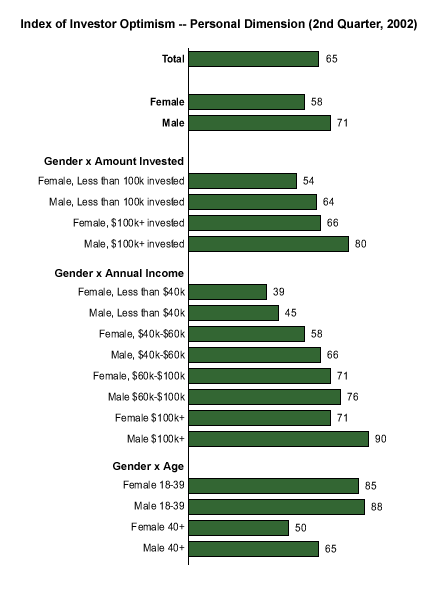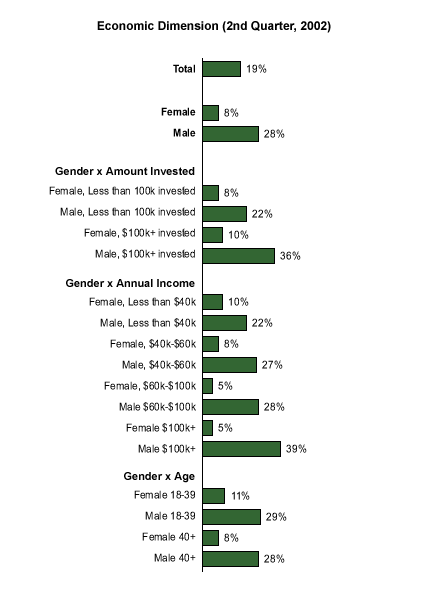This is the second in a series of articles about women and investing.
Women are widely thought to be more pessimistic and conservative investors than men. Last week's article (see "Does Sex Matter When Investing?" in Related Items) discussed the largely persistent appearance of a gender gap in investor optimism. Are these gender differences diminished or magnified in different age groups, investment levels, and income strata?
Data from the Gallup/UBS Index of Investor Optimism* show that women's more pessimistic approaches to investing span various income levels and levels of investment in the current market. Women are dramatically less likely than men to be optimistic about the economy overall in the next 12 months. To a lesser degree, women are also less optimistic about their personal investments. Younger women, however, do appear to be closer to men on the Personal Dimension of the Index.
Optimism About Personal Investments

When it comes to the Index's Personal Dimension, which tracks investors' attitudes about their own financial prospects as opposed to those of the U.S. economy as a whole, overall optimism is very low (65 in the second quarter of 2002 as compared to 76 in June 2001 and 101 in June 2000). As a rule, people with more invested are more optimistic, as are people in higher income brackets and younger people. Among women, however, lower optimism is more persistent than among men, even in the higher income and investment categories. Women from households with $60,000 to $100,000 in annual income, for example, while more optimistic than women with lower incomes, are also still less optimistic about their personal investments than are men with the same household income.
Women over 40 are far more pessimistic than men, but both genders are far more pessimistic than younger people of both genders. While younger women appear to be marginally less optimistic than younger men, the slight difference, suggests that the gender gap regarding personal investments may be largely generational in nature. It is possible that we could see the gender gap in investor optimism diminish over time as today's younger women age.
Optimism About the Economy

The "pessimism gap" between women and men is magnified when respondents are asked to evaluate the economy overall. Women are far more pessimistic about where the economy is headed over the next 12 months, regardless of amount invested, income or age.
An interesting difference between the Personal and Economic Dimensions emerges when looking at income groups. Among male respondents, the higher the household income, the more optimistic they are about the economy. Among women, however, there is a slight downward trend -- higher-income women tend to be slightly less optimistic about the economy than lower-income women. While that difference is slight, it suggests that the increase in personal investment optimism among higher-income women relative to that of lower-income women does not carry over to assessments of the economy overall.
In contrast to the Index's Personal Dimension, where the assessments of younger men and women were similar, the gender gap appears to largely override the age differences on the Economic Dimension. Younger women are slightly more optimistic about the economy than older women are, but the difference is minor (just three points lower than among younger women), while the difference between men and women at each age level is fairly substantial (18 points for younger men versus younger women, and 20 points for older men versus older women).
Key Points
The tendency of women to be less financially optimistic than men does persist across age, income and investment levels, particularly with reference to assessments of the overall economy. Both highly invested and lesser-invested women, as well as both women with higher and lower incomes are less optimistic about the economy and their personal investments than men in those same categories. There is some evidence that the gender gap is narrow among younger people on the Personal Dimension -- suggesting that the overall gap may diminish in future years.
While additional exploration is needed to reveal whether these gender differences carry across different market conditions, it is clear that they exist in the current bear market. The key question is which perspective will lead to the best investment results over the next six to 12 months.
During the bull market of the late 1990s, it was automatically assumed that the less optimistic and more conservative investment preferences of women would lead to sub-par investment performance over time. However, the current investment climate could ultimately vindicate the less optimistic outlook.
Amid the current economic uncertainty, financial observers may want to concern themselves more with the higher probability of overly optimistic men to be attracted to riskier investment strategies.
*Results for the Gallup/UBS Index of Investor Optimism -- U.S. are based on telephone interviews with a randomly selected U.S. sample of 1,006 adult investors, aged 18 and older, with at least $10,000 of investable assets, conducted July 1-14, 2002. For results based on the total sample of 1,000, one can say with 95% confidence that the maximum margin of sampling error is ±3%.

